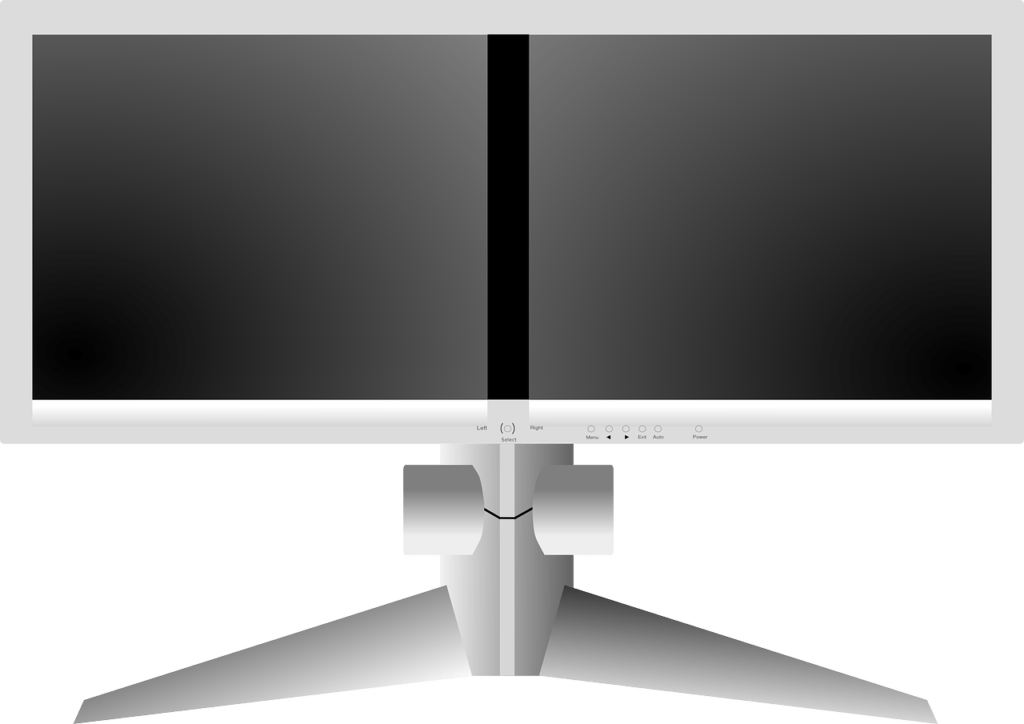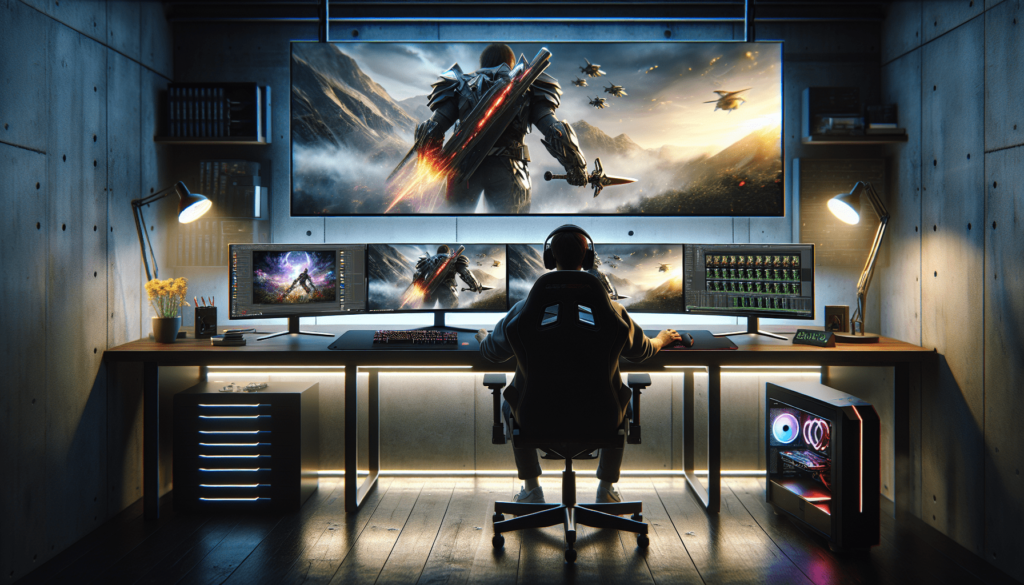How Do I Setup Dual Monitors For Gaming?
In today’s article, we will explore the exciting realm of setting up dual monitors for an immersive gaming experience. With the growing popularity of gaming, many enthusiasts are now seeking ways to enhance their gameplay and maximize their visual real estate. Whether you’re a seasoned gamer or just starting to dip your toes into this exciting world, we’ve got you covered with step-by-step instructions and handy tips to help you seamlessly configure your dual monitors for an unforgettable gaming adventure. So without further ado, let’s jump right in and unlock the full potential of your gaming setup!

Hardware Requirements
Choose compatible monitors
When setting up dual monitors for gaming, it is crucial to choose monitors that are compatible with each other. This means ensuring that both monitors have the same resolution and aspect ratio, as having mismatched monitors can result in distorted graphics and an uneven gaming experience. Additionally, consider the size of the monitors and whether they will fit comfortably on your gaming desk.
Verify graphics card compatibility
Another essential aspect of setting up dual monitors for gaming is ensuring that your graphics card supports multiple monitors. Most modern graphics cards offer dual monitor support, but it is always a good idea to double-check before making any purchases. Check the specifications of your graphics card or consult the manufacturer’s website for information on how many monitors it can handle simultaneously.
Check available ports
Before connecting your monitors to your PC, it is essential to verify the available ports on your graphics card. The most common types of ports are HDMI, DisplayPort, and DVI. Ensure that your monitors have matching ports to the ones on your graphics card. If they do not, you may need to invest in adapters to connect the monitors properly. It is also worth noting that some graphics cards have limitations on the maximum number of monitors that can be connected simultaneously, so be sure to check this as well.
Physical Setup
Positioning monitors
The positioning of your dual monitors can greatly impact your gaming experience. It is recommended to position the monitors side by side to create a seamless and immersive gaming environment. Ensure that the monitors are aligned at the same height and angle to avoid any strain on your neck or eyes. Additionally, consider the lighting in your gaming space and position the monitors away from any glare or direct sunlight that may impact visibility.
Connect monitors to PC
To connect your dual monitors to your PC, start by turning off both the PC and the monitors. Locate the appropriate ports on your graphics card and connect the monitors using the necessary cables. Ensure that the connections are secure and that the cables are not damaged. Once the monitors are connected, you can proceed to turn on your PC and the monitors. Your operating system should automatically detect the monitors and set them up accordingly.
Adjust monitor settings
After connecting your monitors, it is essential to adjust their settings to optimize your gaming experience. Use the built-in controls on each monitor to adjust the brightness, contrast, and color settings according to your preferences. Additionally, ensure that both monitors are set to the same resolution and refresh rate for a consistent and smooth gaming experience. You can access these settings through your operating system’s display settings or the graphics card’s control panel software.

Software Configuration
Update graphics card drivers
To ensure optimal performance and compatibility, it is crucial to keep your graphics card drivers up to date. Outdated drivers can cause issues with dual monitor setups, such as screen flickering or resolution problems. Visit the website of your graphics card manufacturer and download the latest drivers for your specific model. Install the drivers following the manufacturer’s instructions, and restart your PC when prompted. This will ensure that your graphics card is equipped with the latest software enhancements and bug fixes.
Configure display settings
Once your graphics card drivers are up to date, you can proceed to configure the display settings for your dual monitors. Open your operating system’s display settings and navigate to the section where you can manage multiple monitors. Here, you will find options to adjust the orientation, arrangement, and scaling of your monitors. Experiment with these settings to find the configuration that works best for your gaming needs. For example, you may want to extend your desktop across both monitors or duplicate the display on both screens.
Enable dual monitor support
In most cases, your operating system should detect and enable dual monitor support automatically. However, if you encounter any issues or if your monitors are not behaving as expected, you may need to manually enable dual monitor support. This can typically be done through your graphics card’s control panel software. Look for a section dedicated to multiple displays or dual monitor setup and ensure that the necessary options are enabled. Restart your PC after making any changes to ensure that they take effect.
Optimizing Gaming Experience
Select primary monitor
When gaming on dual monitors, it is important to designate one monitor as the primary display. This is the monitor where your game will launch by default, and it will also serve as your primary workspace for other tasks. Selecting the primary monitor can typically be done through your operating system’s display settings or the graphics card’s control panel software. Choose the monitor that is most comfortable for you to focus on during gameplay and set it as the primary display.
Adjust resolution and refresh rate
To optimize your gaming experience, it is crucial to ensure that both monitors are set to the same resolution and refresh rate. Mismatched settings can lead to inconsistent graphics and potential performance issues. Open your operating system’s display settings or the graphics card’s control panel software to adjust the resolution and refresh rate of your monitors. It is recommended to choose a resolution and refresh rate that is supported by both monitors and matches the native capabilities of your graphics card.
Set up monitor alignment
Proper monitor alignment is key to a seamless gaming experience on dual monitors. Ensuring that the images on both monitors align perfectly will prevent any distracting gaps or overlaps in your gaming visuals. Use your operating system’s display settings or the graphics card’s control panel software to fine-tune monitor alignment. You can adjust the position, rotation, and scaling of each monitor to achieve the desired alignment. It may take some trial and error to find the perfect alignment, but it is worth the effort for a visually cohesive gaming setup.

Gaming Setup on Dual Monitors
Choose a suitable game
Not all games are optimized for dual monitor setups, so it is important to choose games that can take full advantage of multiple displays. Look for games that offer native support for dual monitors or have excellent multi-monitor compatibility. These games will typically allow you to stretch the game across both monitors, providing a wider field of view and a more immersive gaming experience. Research online forums and gaming communities to find recommendations for games that work well on dual monitors.
Enable fullscreen or borderless window mode
When launching a game on dual monitors, ensure that you select either fullscreen or borderless window mode to maximize the use of both displays. These modes will prevent any distractions or gaps caused by the taskbar or other desktop elements. Fullscreen mode will take up the entire screen space, while borderless window mode will allow you to easily switch between the game and other applications on your secondary monitor. Experiment with both modes to find the one that suits your preferences.
Adjust game settings
Each game may have specific settings that can be adjusted to optimize the gaming experience on dual monitors. Look for options related to resolution, aspect ratio, field of view, and multi-monitor support. Adjusting these settings can greatly enhance the visuals and gameplay on dual monitors. It is recommended to consult the game’s official documentation or online guides for specific instructions on how to optimize the game for dual monitor setups. Take the time to experiment with different settings to find the configuration that works best for each game.
Dealing with Common Issues
Troubleshoot display detection problems
In some cases, you may encounter issues with your dual monitor setup, particularly related to the detection of the monitors by your operating system. If one or both monitors are not being detected, first ensure that the connections are secure and that the monitors are powered on. Try disconnecting and reconnecting the cables, or testing different cables if available. If the problem persists, check your operating system’s display settings or the graphics card’s control panel software for options to manually detect and configure the monitors.
Address resolution disparities
If you notice resolution disparities between the two monitors, where the image appears stretched or pixelated on one monitor, there are a few steps you can take to address this issue. Firstly, ensure that both monitors are set to the same resolution in your operating system’s display settings or the graphics card’s control panel software. If the issue persists, check your monitor’s settings for options related to aspect ratio or scaling. Adjusting these settings can help align the resolution on both monitors and provide a consistent visual experience.
Resolve game compatibility issues
Occasionally, you may encounter game compatibility issues when playing on dual monitors. These issues can manifest in various ways, such as stretched or distorted graphics, black bars on one monitor, or the game displaying on the wrong monitor. To resolve these issues, first ensure that your game and graphics card drivers are up to date. If the problem persists, consult the game’s official documentation or support forums for specific instructions on how to optimize the game for dual monitor setups. You may need to adjust the game’s settings or apply patches or mods to achieve the desired functionality.

Additional Tips and Considerations
Invest in a monitor stand or mount
To maximize desk space and improve ergonomic positioning, consider investing in a monitor stand or mount for your dual monitor setup. These accessories allow you to raise the monitors to eye level, reducing strain on your neck and improving overall comfort during gaming sessions. Additionally, a monitor stand or mount can help eliminate clutter and provide a cleaner aesthetic to your gaming setup. Look for stands or mounts that are designed to accommodate dual monitors and have adjustable height and tilt options for optimal customization.
Consider using multiple graphics cards
For those looking to take their dual monitor gaming setup to the next level, consider using multiple graphics cards in a multi-GPU configuration. This setup involves installing multiple graphics cards in your PC and utilizing their combined power to drive your dual monitors. Not only can this improve gaming performance, but it can also allow for even more immersive and demanding gaming experiences. However, it is essential to ensure that your motherboard and power supply can support multiple graphics cards before attempting this setup.
Choose monitors with thin bezels
When selecting monitors for your dual monitor gaming setup, consider choosing models with thin bezels. Thin bezels minimize the gap between the screens, providing a more seamless and cohesive visual experience. This eliminates any distractions or interruptions caused by thick borders between the two monitors. Additionally, monitors with thin bezels are aesthetically pleasing and create a sleek and modern look for your gaming setup. Look for monitors specifically marketed as “borderless” or “frameless” for the best results.
In conclusion, setting up dual monitors for gaming can greatly enhance your gaming experience, providing a wider field of view, improved immersion, and enhanced productivity. By carefully selecting compatible monitors, ensuring graphics card compatibility, and adjusting settings both physically and within the software, you can create a seamless dual monitor gaming setup. Additionally, by addressing common issues and considering additional tips and considerations, you can further optimize your setup to meet your specific gaming needs. Get ready to level up your gaming experience with dual monitors!




